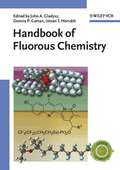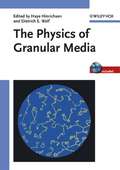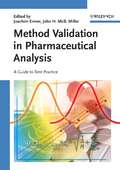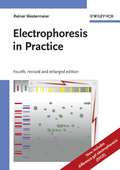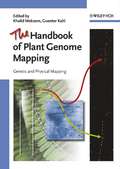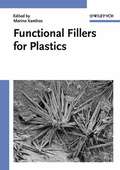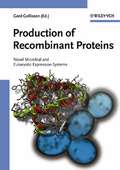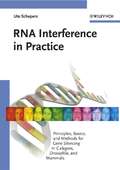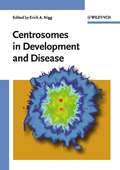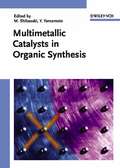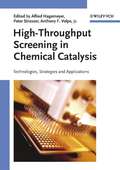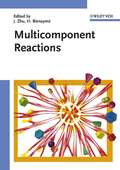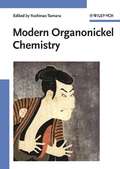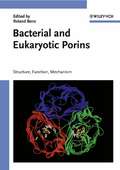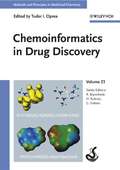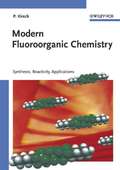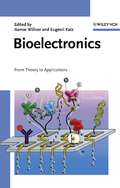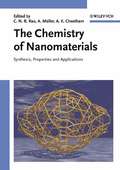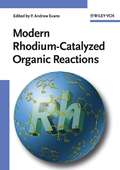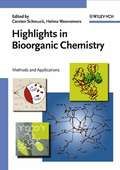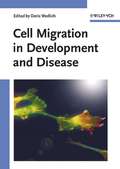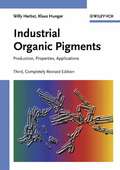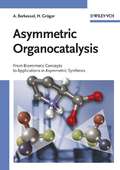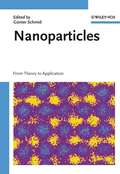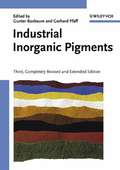- Table View
- List View
Handbook of Fluorous Chemistry
by John A. Gladysz Dennis P. Curran István T. HorváthEdited by the leading experts John Gladysz, Dennis Curran, and Istvan Horvath, this handbook is the first to summarize all the essential aspects of this emerging field of chemistry. Whether the reader is seeking an introduction to the concept of fluorous biphase catalysis, summaries of partition coefficients involving fluorous and organic solvents, or information on the latest fluorous mixture separation techniques, this authoritative compilation of contributions, written by the world's top authors, provides key information needed for successfully working with the diverse and fascinating families of fluorous molecules. The large number of reliable experimental procedures in particular makes this the ideal guide for newcomers wanting to use this elegant method in the laboratory. In addition, experts will also find a wealth of important information concisely contained in one ready reference. The result is an indispensable resource for everyone currently working or intending to work in this field.
The Physics of Granular Media
by Haye Hinrichsen Dietrich E. WolfDespite extensive empirical experience, there is both a scientific challenge and a technological need to develop an understanding of the mechanisms underlying the flow of grains. This new reference provides quick access to the current level of knowledge, containing review articles covering recent developments in the field of granular media from the viewpoints of applied, experimental, and theoretical physics. In short, a must-have for advanced researchers and specialists as well as a useful starting point for anyone entering this field. The authors represent different directions of research in the field, with their contributions covering: - Static properties - Granular gases - Dense granular flow - Hydrodynamic interactions - Charged and magnetic granular matter - Computational aspects
Method Validation in Pharmaceutical Analysis: A Guide to Best Practice
by Joachim Ermer John H. McB. MillerAdopting a practical approach, the authors provide a detailed interpretation of the existing regulations (GMP, ICH), while also discussing the appropriate calculations, parameters and tests. The book thus allows readers to validate the analysis of pharmaceutical compounds while complying with both the regulations as well as the industry demands for robustness and cost effectiveness. Following an introduction to the basic parameters and tests in pharmaceutical validation, including specificity, linearity, range, precision, accuracy, detection and quantitation limits, the text focuses on a life-cycle approach to validation and the integration of validation into the whole analytical quality assurance system. The whole is rounded off with a look at future trends. With its first-hand knowledge of the industry as well as regulating bodies, this is an invaluable reference for analytical chemists, the pharmaceutical industry, pharmaceutists, QA officers, and public authorities.
Electrophoresis in Practice: A Guide to Methods and Applications of DNA and Protein Separations
by Reiner WestermeierThis laboratory guide for successful electrophoretic separations is divided into two parts to provide readers with a thorough presentation of the fundamentals followed by a detailed description of the most common methods currently in use. This fourth edition retains the successful concept of its predecessors, yet features a brand-new layout, and is further enhanced by a section on difference gel electrophoresis, while the chapter on proteome analysis is practically all new and considerably extended, plus there are now around 10 % new literature references.
The Handbook of Plant Genome Mapping: Genetic and Physical Mapping
by Khalid Meksem Guenter KahlWhile the complete sequencing of the genomes of model organisms such as a multitude of bacteria and archaea, the yeast Saccharomyces cerevisiae, the worm Caenorhabditis elegans, the fly Drosophila melanogaster, and the mouse and human genomes have received much public attention, the deciphering of plant genomeswas greatly lagging behind. Up to now, only two plant genomes, one of the model plant Arabidopsis thaliana and one of the crop species rice (Oryza sativa) have been sequenced, though a series of other crop genome sequencing projects are underway. Notwithstanding this public bias towards genomics of animals and humans, it is nevertheless of great importance for basic and applied sciences and industries in such diverse fields as agriculture, breeding in particular, evolutionary genetics, biotechnology, and food science to know the composition of crop plant genomes in detail. It is equally crucial for a deeper understanding of the molecular basis of biodiversity and synteny. The Handbook of Genome Mapping: Genetic and Physical Mapping is the first book on the market to cover these hot topics in considerable detail, and is set apart by its combination of genetic and physical mapping. Throughout, each chapter begins with an easy-to-read introduction, also making the book the first reference designed for non-specialists and newcomers, too. In addition to being an outstanding bench work reference, the book is an excellent textbook for learning and teaching genomics, in particular for courses on genome mapping. It also serves as an up-to-date guide for seasoned researchers involved in the genetic and physical mapping of genomes, especially plant genomes.
Functional Fillers for Plastics
by Marino XanthosA comprehensive and up-to-date overview of the major mineral and organic fillers for plastics, their production, structure and properties, as well as their applications in terms of primary and secondary functions. Edited and co-authored by Professor Marino Xanthos with contributions by international experts from industry and academia, the book presents methods of mixing/incorporation technologies, surface treatments and modifications for enhanced functionality, an analysis of parameters affecting filler performance and a presentation of current and emerging applications. Additionally, the novel classification according to modification of specific polymer properties rather than filler chemical composition will provide a better understanding of the relationships between processing, structure and properties of products containing functional fillers and the identification of new markets and applications. For engineers, scientists and technologists involved in the industrially important sector of polymer composites.
Production of Recombinant Proteins: Novel Microbial and Eukaryotic Expression Systems
by Gerd GellissenWhile the choices of microbial and eukaryotic expression systems for production of recombinant proteins are many, most researchers in academic and industrial settings do not have ready access to pertinent biological and technical information since it is normally scattered throughout the scientific literature. This book closes the gap by providing information on the general biology of the host organism, a description of the expression platform, a methodological section -- with strains, genetic elements, vectors and special methods, where applicable -- as well as examples of proteins produced with the respective platform. The systems thus described are well balanced by the inclusion of three prokaryotes (two Gram-negatives and one Gram-positive), four yeasts, two filamentous fungi and two higher eukaryotic cell systems -- mammalian and plant cells. Throughout, the book provides valuable practical and theoretical information on the criteria and schemes for selecting the appropriate expression platform, the possibility and practicality of a universal expression vector, and on comparative industrial-scale fermentation, with the production of a recombinant Hepatitis B vaccine chosen as an industrial example. With a foreword by Herbert P. Schweizer, Colorado State University, USA: "As a whole, this book is a valuable and overdue resource for a varied audience. It is a practical guide for academic and industrial researchers who are confronted with the design of the most suitable expression platform for their favorite protein for technical or pharmaceutical purposes. In addition, the book is also a valuable study resource for professors and students in the fields of applied biology and biotechnology."
RNA Interference in Practice: Principles, Basics, and Methods for Gene Silencing in C. elegans, Drosophila, and Mammals
by Ute SchepersThis hands-on guide to RNA interference brings the power of targeted gene silencing to any laboratory with the basic equipment for handling nucleic acids. In easy-to-follow, step-by-step protocols you will learn * how RNAi works in worms, flies and mammals, * how to design the most efficient RNAi constructs, * how to achieve transient, stable and conditional RNAi in cell cultures, * how to determine the efficiency of an RNAi experiment, * and how to use RNAi for gene therapy. All the protocols have been thoroughly tested in the author's own laboratory, and she provides examples of successful experiments and troubleshooting hints to help in establishing your own successful RNAi experiments. Also includes a list of suppliers for RNAi reagents and equipment as well as a glossary of terms.
Centrosomes in Development and Disease
by Erich A. NiggDiscovered over a century ago, the centrosome is the major microtubule organizing center of the animal cell. It is a tiny organelle of surprising structural complexity. Over the last few years our understanding of the structure and composition of centrosomes has greatly advanced, and the demonstration of frequent centrosome anomalies in most common human tumors has sparked additional interest in the role of this organelle in a broader scientific community. The centrosome controls the number and distribution of microtubules - a major element of the cell cytoskeleton - and hence influences many important cellular functions and properties. These include cell shape, polarity, and motility, as well as the intracellular transport and positioning of various organelles. Of particular interest, centrosome function is critical for chromosome segregation and cell division. This book is meant to summarize our current knowledge of the structure, function and evolution of microtubule organizing centers, primarily centrosomes. Emphasis is on the role of these organelles in development and disease (particularly cancer).
Multimetallic Catalysts in Organic Synthesis
by Masakatsu Shibasaki Yoshinori YamamotoThis first book to comprehensively cover this hot topic presents the information hitherto scattered throughout smaller reviews or single book chapters to provide an introduction to this rapidly expanding field. In ten chapters, the international team of expert authors treats asymmetric syntheses, new transformations, and organometallic reactions using homo- and hetero-bimetallic catalysts. Written for advanced researchers, this very timely publication is of significant benefit to organic and organometallic chemists in both academia and industry.
High-Throughput Screening in Chemical Catalysis: Technologies, Strategies and Applications
by Alfred Hagemeyer Peter Strasser Anthony F. VolpeIn this first book to present every important aspect of this fascinating and developing field, the three editors A. Hagemeyer, P. Strasser and A. F. Volpe Jr. from Symyx Technologies have chosen a perfect mixture of distinguished, international authors from both academia and industry. Each chapter is devoted to a major topic - high-throughput experimentation methodologies, integrated combinatorial synthesis and screening workflow, and applications to chemical catalysts with an emphasis on heterogeneous catalysis, olefin polymerization and electrocatalysis for fuel cells. An indispensable source for everyone working in the field.
Multicomponent Reactions
by Jieping Zhu Hugues BienayméIn the very first book on this hot topic, the expert editors and authors present a comprehensive overview of these elegant reactions. From the contents: Organoboron compounds Free-radical mediated multicomponent coupling reactions Applications in drug discovery Metal catalyzed reactions Total synthesis of natural products Asymmetric isocyanide-based reactions The Biginelli reaction Asymmetric isocyanide-based reactions The Domino-Knoevenagel-Hetero-Diels-Alder Reaction and related transformations Catalytic asymmetric reactions Algorithm based methods for discovering novel reactions Post-condensation modifications of the Passerini and Ugi reactions An essential reference for organic and catalytic chemists, and those working in organometallics both in academia and industry.
Modern Organonickel Chemistry
by Yoshinao TamaruOrganonickel chemistry plays an increasingly important role in organic chemistry, and interest in this topic is now just as keen as in organopalladium chemistry. While there are numerous, very successful books on the latter, a book specializing in organonickel chemistry is long overdue. Edited by one of the leading experts in the field, this volume covers the many discoveries made over the past 30 years, and previously scattered throughout the literature. Active researchers working at the forefront of organonickel chemistry provide a comprehensive review of the topic, including cross-coupling reactions, asymmetric synthesis and heterogeneous catalysis reaction types. A must-have for both organometallic chemists and synthetic organic chemists.
Bacterial and Eukaryotic Porins: Structure, Function, Mechanism
by Roland BenzThis first book dedicated to the topic relates the known physiological functions of porins to their molecular structure and mechanism, as documented by various in vitro and in vivo methods, including the generation of null mutants in mice. For the first time, it brings together biophysical evidence with studies performed in a cellular context, presenting a unified picture of the fundamental importance of porins for cellular function. With 16 contributions by an interdisciplinary team of leading porin researchers, this reference is essential reading for every molecular or structural biologist with an interest in this essential protein family.
Chemoinformatics in Drug Discovery (Methods and Principles in Medicinal Chemistry #23)
by Raimund Mannhold Hugo Kubinyi Gerd FolkersThis handbook provides the first-ever inside view of today's integrated approach to rational drug design. Chemoinformatics experts from large pharmaceutical companies, as well as from chemoinformatics service providers and from academia demonstrate what can be achieved today by harnessing the power of computational methods for the drug discovery process. With the user rather than the developer of chemoinformatics software in mind, this book describes the successful application of computational tools to real-life problems and presents solution strategies to commonly encountered problems. It shows how almost every step of the drug discovery pipeline can be optimized and accelerated by using chemoinformatics tools -- from the management of compound databases to targeted combinatorial synthesis, virtual screening and efficient hit-to-lead transition. An invaluable resource for drug developers and medicinal chemists in academia and industry.
Modern Fluoroorganic Chemistry: Synthesis, Reactivity, Applications
by Peer KirschIn this handbook, Peer Kirsch clearly shows that this exciting field is no longer an exotic area of research. Aimed primarily at synthetic chemists wanting to gain a deeper understanding of the fascinating implications of including the highly unusual element fluorine in organic compounds, the main part of the book presents a wide range of synthetic methodologies and the experimental procedures selected undeniably show that this can be done with standard laboratory equipment. To round off, the author looks at fluorous chemistry and the applications of organofluorine compounds in liquid crystals, polymers and more besides. This long-awaited book represents an indispensable source of high quality information for everyone working in the field.
Bioelectronics: From Theory to Applications
by Eugenii Katz Itamar WillnerMedicine, chemistry, physics and engineering stand poised to benefit within the next few years from the ingenuity of complex biological structures invented and perfected by nature over millions of years. This book provides both researchers and engineers as well as students of all the natural sciences a vivid insight into the world of bioelectronics and nature's own nanotechnological treasure chamber.
The Chemistry of Nanomaterials: Synthesis, Properties and Applications
by C. N. R. Rao Achim Müller Anthony K. CheethamWith this handbook the distinguished team of editors has combined the expertise of leading nanomaterials scientists to provide the latest overview of this field. The authors cover the whole spectrum of nanomaterials, ranging from theory, synthesis, properties, characterization to application, including such new developments as: quantum dots, nanoparticles, nanoporous materials, as well as nanowires, nanotubes and nanostructural polymers nanocatalysis, nanolithography, nanomanipulation methods for the synthesis of nanoparticles. The book can thus be recommended for everybody working in nanoscience: Beginners can acquaint themselves with the exciting subject, while specialists will find answers to all their questions plus helpful suggestions for further research.
Modern Rhodium-Catalyzed Organic Reactions
by P. Andrew Evans Jiro TsujiRhodium has proven to be an extremely useful metal due to its ability to catalyze an array of synthetic transformations, with quite often-unique selectivity. Hydrogenation, C-H activation, allylic substitution, and numerous other reactions are catalyzed by this metal, which presumably accounts for the dramatic increase in the number of articles that have recently emerged on the topic. P. Andrew Evans, the editor of this much-needed book, has assembled an internationally renowned team to present the first comprehensive coverage of this important area. The book features contributions from leaders in the field of rhodium-catalyzed reactions, and thereby provides a detailed account of the most current developments, including: Rhodium-Catalyzed Asymmetric Hydrogenation (Zhang) Rhodium-Catalyzed Hydroborations and Related Reactions (Brown) Rhodium-Catalyzed Asymmetric Addition of Organometallic Reagents to Electron Deficient Olefins (Hayashi) Recent Advances in Rhodium(I)-Catalyzed Asymmetric Olefin Isomerization and Hydroacylation Reactions (Fu) Stereoselective Rhodium(I)-Catalyzed Hydroformylation and Silylformylation Reactions and Their Application to Organic Synthesis (Leighton) Carbon-Carbon Bond-Forming Reactions Starting from Rh-H or Rh-Si Species (Matsuda) Rhodium(I)-Catalyzed Cycloisomerization and Cyclotrimerization Reactions (Ojima) The Rhodium(I)-Catalyzed Alder-ene Reaction (Brummond) Rhodium-Catalyzed Nucleophilic Ring Cleaving Reactions of Allylic Ethers and Amines (Fagnou) Rhodium(I)-Catalyzed Allylic Substitution Reactions and their Applications to Target Directed Synthesis (Evans) Rhodium(I)-Catalyzed [2+2+1] and [4+1] Carbocyclization Reactions (Jeong) Rhodium(I)-Catalyzed [4+2] and [4+2+2] Carbocyclizations (Robinson) Rhodium(I)-Catalyzed [5+2], [6+2], and [5+2+1] Cycloadditions: New Reactions for Organic Synthesis (Wender) Rhodium(II)-Stabilized Carbenoids Containing both Donor and Acceptor Substituents (Davies) Chiral Dirhodium(II)Carboxamidates for Asymmetric Cyclopropanation and Carbon-Hydrogen Insertion Reactions (Doyle) Cyclopentane Construction by Rhodium(II)-Mediated Intramolecular C-H Insertion (Taber) Rhodium(II)-Catalyzed Oxidative Amination (DuBois) Rearrangement Processes of Oxonium and Ammonium Ylides Formed by Rhodium(II)-Catalyzed Carbene-Transfer (West) Rhodium(II)-Catalyzed 1,3-Dipolar Cycloaddition Reactions (Austin) "Modern Rhodium-Catalyzed Organic Reactions" is an essential reference text for researchers at all levels in the general area of organic chemistry. This book provides an invaluable overview of the most significant developments in this important area of research, and will no doubt be an essential text for researchers at academic institutions and professionals at pharmaceutical/agrochemical companies.
Highlights in Bioorganic Chemistry: Methods and Applications
by Carsten Schmuck Helma Wennemers Ronald BreslowThis is a fascinating introduction to the topic. Spanning the spectrum of nucleic acid chemistry, carbohydrates, peptides, molecular recognition, biosynthesis and natural biosynthesis, right up to medical and biophysical chemistry, the book provides advanced students and those already working in the field with a balanced overview. In more than 30 contributions, a new generation of recognized scientists gives an account of the latest research in such areas as * Artificial receptors for the stabilization of ?-sheet structures * Carbohydrate recognition by artificial receptors * Combinatorial chemistry as a tool for the discovery of catalysts * The interaction of NO and peroxynitrite with hemoglobin and myoglobin * Inhibitors against human mast-cell-tryptase as a potential approach to conquering asthma * The selectivity of DNA replication. A readily accessible survey for everyone wishing to stay abreast of developments. With a Foreword by Ronald Breslow.
Cell Migration in Development and Disease
by Doris WedlichCell Migration matches nearly all research areas in cell and developmental biology, genetics, and biomedicine. The field shows radical progress powered by the combination of new genomic tools, cell labeling techniques and the incorporation of new model systems. This is the first book to comprehensively cover cell migration from the identification of molecular mechanisms to the understanding of certain pathological disorders and cancer development.
Industrial Organic Pigments: Production, Properties, Applications
by Willy Herbst Klaus Hunger'Everything there is to know about organic pigments' Revised and updated, this highly acclaimed work, now in its third edition, remains the most comprehensive source of information available on synthetic organic pigments. The book provides up-to-date information on synthesis, reaction mechanisms, physical and chemical properties, test methods, and applications of all industrially produced organic pigments of the world market. Standardized methods have been used to obtain the data thus facilitating comparison between pigments. Chemists, engineers, colorists, and technicians are sure to find this book invaluable. 'Presentation throughout is of the highest quality and the volume must now become the standard reference text in this important area of colouring matters.' Dyes and Pigments 'This is a very wide-ranging reference work ... it would be difficult to find a topic in this field not covered by this book.' Ecochem
Asymmetric Organocatalysis: From Biomimetic Concepts to Applications in Asymmetric Synthesis
by Albrecht Berkessel Harald GrögerAsymmetric catalysis represents still one of the major challenges in modern organic chemistry. Besides the well-established asymmetric metal-complex-catalysed syntheses and biocatalysis, the use of "pure" organic catalysts turned out to be an additional efficient tool for the synthesis of chiral building blocks. In this handbook, the experienced authors from academia and industry provide the first overview of the important use of such metal-free organic catalysts in organic chemistry. With its comprehensive description of numerous reaction types, e.g., nucleophilic substitution and addition reactions as well as cycloadditions and redox reactions, this book targets organic chemists working in industry and academia, and deserves a place in every laboratory.
Nanoparticles: From Theory to Application
by Günter SchmidAn introduction to the science of nanoparticles, from fundamental principles to their use in novel applications. As a basis for understanding nanoparticle behavior, the book first outlines the principles of quantum size behavior, nanoparticles architecture, formation of semiconductor and metal nanoparticles. It then goes on to describe the chemical syntheses of nanoparticles with defined characteristics, their structural, electrical and magnetic properties, as well as current methods to monitor these properties. Among others, the following nanoparticle-based applications are discussed: Single-electron devices Ultra dense recording media Bioelectronic devices and sensors Labeling of proteins, nucleic acids and other biomaterials. With its clear structure and comprehensive coverage, backed by numerous examples from the recent literature, this is a prime reference for chemists and materials scientists working with and developing nanoparticle systems.
Industrial Inorganic Pigments
by Gunter Buxbaum Gerhard PfaffInorganic Pigments significantly change our surroundings. They are irreplaceable for the coloring of construction materials - their applications range from concrete to artist's colors, from industrial paints to toners in photocopiers, from coloring in foodstuffs to raw materials for catalysts. This book offers everything there is to know about inorganic pigments in a concise and thorough presentation: their manufacturing processes, their applications and markets, their testing procedures and standards, and also the health and environmental regulations relating to them. The reader is provided with more than 800 up-to-date references to the pertinent literature, which will be extremely useful for further studies. Over 30 first-class authors from leading chemical companies have created a uniform and clearly structured text, giving an excellent overview of the subject area. This book will be of benefit to all chemists, materials specialists, engineers, application technicians and students in pigment-related fields. '... the book under review is a class by itself...gives very useful information to the paint chemist regarding the basics and application aspects of the various pigments used in the chemical industry.' (Bulletin of Electrochemistry)
